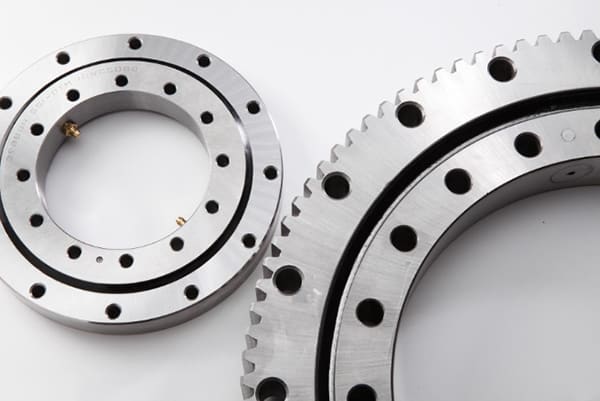
How to Select a Slew Bearing?
2024-09-24
Slew bearings, also known as slewing rings, are integral components in machinery that require rotational movement with heavy loads, such as cranes, wind turbines, excavators, and industrial robots. Choosing the right slew bearing is crucial for ensuring the smooth operation and longevity of the machinery. With various designs and specifications available, selecting the appropriate slew bearing can be challenging. This article outlines key factors to consider when selecting a slew bearing to ensure optimal performance, reliability, and durability.
1. Load Capacity
The primary factor to consider when selecting a slew bearing is the load it will need to support. Slew bearings typically handle three types of loads:
- Axial loads (forces parallel to the axis of rotation)
- Radial loads (forces perpendicular to the axis)
- Moment loads (forces causing a tilting motion).
The magnitude and direction of these loads need to be assessed carefully. Overestimating or underestimating the load-bearing requirements can lead to improper selection, resulting in excessive wear, premature failure, or even damage to the entire machine. Choose a slew bearing that matches or exceeds the maximum loads expected during the operation.
2. Rotational Speed and Accuracy
The speed at which the bearing will rotate is another crucial factor. Slew bearings are available in various designs to cater to different speed requirements. Lower-speed applications, such as cranes or excavators, typically require bearings that prioritize load capacity over speed. On the other hand, high-speed applications, such as rotating platforms or machinery that requires precise positioning, will benefit from bearings designed for higher rotational accuracy and smoother movement.
Ensure that the selected bearing can operate efficiently at the required speed without compromising accuracy or experiencing undue friction and heat buildup, which could degrade performance over time.
3. Bearing Type
Slew bearings come in several types, each designed for different applications:
- Single-row ball bearings: These are suitable for light to medium loads and are often used in applications requiring minimal space.
- Double-row ball bearings: Designed for higher load capacities, these are ideal for heavier machinery.
- Crossed roller bearings: These provide high rigidity and are suitable for applications with high moment loads and precision requirements.
- Three-row roller bearings: These bearings are specifically designed for heavy loads and large equipment. They offer excellent support for axial, radial, and moment loads.
Choosing the correct type of bearing is essential for ensuring it can handle the specific operational demands of your machinery.
4. Environmental Conditions
The operating environment plays a significant role in the selection process. Slew bearings must withstand harsh conditions, such as:
- Extreme temperatures: High or low temperatures can affect the material properties and performance of the bearing. Bearings for high-temperature environments should be made from materials that can withstand heat without expanding excessively or losing strength.
- Corrosion: In environments with high humidity or exposure to corrosive chemicals, bearings made of corrosion-resistant materials, such as stainless steel, are crucial for maintaining durability.
- Dust and debris: For applications in dirty or dusty environments, such as construction sites, bearings with effective seals and proper lubrication systems should be selected to prevent contamination that can lead to premature wear.
5. Size and Weight
Slew bearings come in a variety of sizes, and selecting the right size is vital for ensuring compatibility with the machinery. Oversized or undersized bearings can lead to inefficient operation, excessive wear, and damage to the equipment. Ensure that the selected bearing fits the available space in the design without requiring significant modifications to the machine.
In addition to size, the weight of the bearing is another consideration, particularly in mobile applications like cranes or wind turbines, where minimizing weight is crucial to maintaining balance and efficiency.
6. Lubrication Requirements
Proper lubrication is essential for reducing friction and ensuring smooth operation. Some slew bearings come pre-lubricated, while others require periodic maintenance. Consider whether the selected bearing offers accessible lubrication points and if its lubrication needs align with the operational maintenance schedule of the machinery. For applications in environments where frequent maintenance is not feasible, self-lubricating bearings or those with long-lasting grease should be considered.
7. Cost and Availability
While cost is always a factor, it’s important not to sacrifice quality for a lower price. The initial cost of a slew bearing should be weighed against its expected lifespan, maintenance requirements, and performance. A cheaper bearing that requires frequent replacement or repairs can lead to higher long-term costs. Also, ensure that the selected bearing is readily available in the market and that replacement parts are accessible in case of future repairs.
Conclusion
Selecting the right slew bearing involves a comprehensive understanding of the machinery’s operational needs and the bearing’s capabilities. By considering factors such as load capacity, rotational speed, bearing type, environmental conditions, size, lubrication, and cost, you can make an informed decision that ensures optimal performance and long-lasting durability for your equipment. Proper selection can not only enhance operational efficiency but also reduce maintenance costs and downtime, ensuring smooth, reliable performance for years to come.






